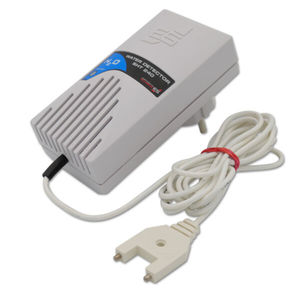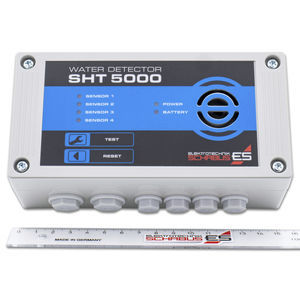
- Detection - Measurement
- Position, Speed and Acceleration Measurements
- Optical detector
- Elektrotechnik Schabus
Optical detector SHT 227acousticliquid

Add to favorites
Compare this product
Characteristics
- Technology
- optical, acoustic, liquid
Description
The SHT 227 socket water detector functions as a pump control. If a certain water level is detected with the mini float switch, the socket switches on the connected pump and an alarm sounds. After the water level drops below the specified level, the pump continues to run for an adjustable follow-up time of 0 to 100 seconds, is then switched off and the alarm stops again.
Possible applications
Water ingress
Pump sump
Cistern monitoring
Also suitable for other liquids (e.g. heating oil, diesel, vegetable oil, lubricating oils, etc.)
DESCRIPTION
Functional description:
The SHT 227 water detector is a plug-in pump control which switches on a connected water pump when a certain water level is reached and also switches it off again after the water and thus the float have sunk, as well as a specified time. An infinitely variable dial is used to set the pump's run-on time from 0 to 100 seconds. An acoustic and optical warning signals the water level change.
The robust float switch is particularly suitable for dirty water, damp environments or other liquids (e.g. heating oil, diesel, vegetable oil, lubricating oil, etc.).
In addition, a float switch, in contrast to a sensor, stands for higher reliability in the shutdown behavior of the pump.
The switch contact of the float closes at a level of approx. 4 cm and activates the input of the water detector.
input of the water detector. By turning the float body around, the reverse switching
the reverse switching function.
Without acoustic alarm:
The same device is available as a water detector SHT 228 without acoustic alarm.
Extension sensor cable:
If required, you can extend the sensor cable up to 50 m with a cable
Related Searches
- Gas detector
- Monitoring detector
- Compact detector
- CO detector
- Optical detector
- Detector with alarm
- Electric current detector
- LED detector
- Cable detector
- Combination detector
- Vehicle detector
- Electronic detector
- Mobile detector
- Oil detector
- Acoustic detector
- Contact detector
- Liquid detector
- Liquid detector
- Piezoelectric detector
- Plug detector
*Prices are pre-tax. They exclude delivery charges and customs duties and do not include additional charges for installation or activation options. Prices are indicative only and may vary by country, with changes to the cost of raw materials and exchange rates.








